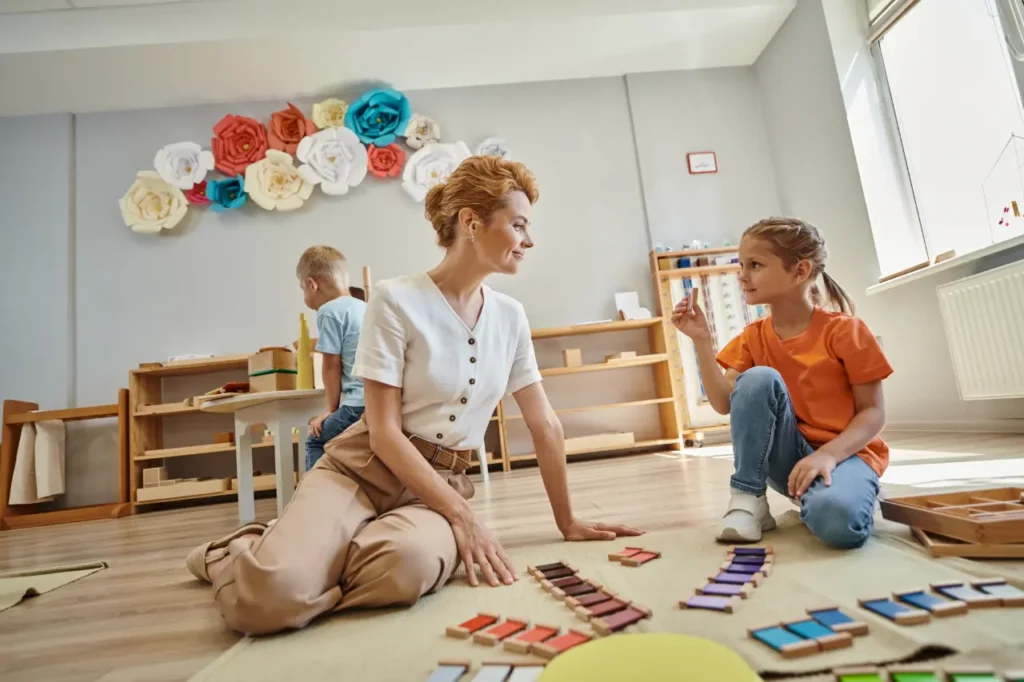Choosing the right preschool for your child is a significant decision. It sets the foundation for their lifelong learning journey.
Montessori preschools offer a unique approach to education. They focus on child-led learning, fostering independence and curiosity.
But what exactly is Montessori education? How does it differ from traditional preschools?
This guide aims to answer these questions. It will provide you with a comprehensive understanding of Montessori principles and practices.
You’ll learn about the role of Montessori teachers, the importance of the learning environment, and the benefits of Montessori education.
We’ll also guide you through the process of choosing a Montessori preschool that aligns with your child’s learning needs.
Whether you’re a parent, an educator, or simply interested in Montessori education, this guide is for you. Let’s embark on this journey together.
Understanding Montessori Education
Montessori education is a child-centered approach to learning. It was developed by Dr. Maria Montessori, an Italian physician and educator, in the early 20th century.
This method of education is based on scientific observations of children. It respects and supports each child’s unique development and potential.
The Montessori approach is characterized by several key principles. These include:
- Respect for the child
- The prepared environment
- The teacher as a guide
- Child-led learning
- Mixed-age classrooms
The Montessori Philosophy
The Montessori philosophy is rooted in a deep respect for the child. It recognizes children as individuals with their own interests, abilities, and pace of learning.
This philosophy emphasizes the importance of child-led learning. Children are encouraged to explore and discover on their own, fostering a love for learning.
The goal of Montessori education is not just academic success. It aims to nurture the whole child, developing their physical, social, emotional, and cognitive abilities.
Key Components of Montessori Learning
One of the key components of Montessori learning is the prepared environment. This is a carefully arranged, child-sized space designed to facilitate independent learning.
Montessori materials play a crucial role in this environment. These hands-on learning tools are designed to stimulate the child’s senses and promote self-directed learning.
Another unique feature of Montessori learning is the mixed-age classroom. This setup allows younger children to learn from older ones, fostering a sense of community and cooperation.
The Montessori Classroom Environment
The Montessori classroom environment is a key element of Montessori education. It is designed to foster independence, exploration, and learning at the child’s own pace.
The classroom is carefully arranged with child-sized furniture and materials. This allows children to move freely and choose their own activities.
The environment is also designed to be calm and orderly. This helps children to focus and engage deeply with their work.
In a Montessori classroom, children are encouraged to explore and learn through their senses. This hands-on approach to learning is a hallmark of Montessori education.
Role of Montessori Materials
Montessori materials are carefully designed learning tools. They are used to help children explore and understand the world around them.
Each material is designed to teach a specific concept or skill. For example, the Pink Tower helps children understand size and order, while the Sandpaper Letters introduce them to letter shapes and sounds.
The materials are also self-correcting. This means that children can see and correct their own mistakes, promoting independence and self-confidence.
The Importance of Mixed-Age Groups
Mixed-age groups are a distinctive feature of Montessori classrooms. Children are grouped in three-year age spans, such as 3-6 or 6-9 years.
This setup allows younger children to learn from older ones. It also gives older children the opportunity to reinforce their knowledge by teaching others.
Mixed-age groups also promote social skills and empathy. Children learn to respect and help each other, fostering a sense of community and cooperation.
Montessori Teachers and Their Approach
Montessori teachers play a unique role in the classroom. Unlike traditional teachers, they act as guides and facilitators of learning.
They observe each child closely, identifying their interests and readiness for new challenges. They then present appropriate materials or activities, sparking curiosity and engagement.
Montessori teachers also respect each child’s individual pace of learning. They give children the freedom to explore and learn at their own speed, fostering a love for learning.
Guiding Instead of Teaching
In a Montessori classroom, the teacher’s role is to guide rather than instruct. They create an environment where children can learn through exploration and discovery.
Teachers provide individual or small group lessons when a child is ready. They then step back, allowing the child to work independently and learn from their own experiences.
This approach respects the child’s natural desire to learn. It also fosters independence, self-confidence, and a lifelong love for learning.
Montessori Teacher Qualifications
Becoming a Montessori teacher requires specialized training. This training focuses on the Montessori philosophy, child development, and the use of Montessori materials.
Most Montessori teacher training programs require a bachelor’s degree. They also include a practicum component, where trainees gain hands-on experience in a Montessori classroom.
It’s important to note that not all Montessori schools require their teachers to have Montessori certification. However, a certified teacher has a deep understanding of the Montessori approach and is better equipped to implement it effectively.
Montessori vs. Traditional Preschools
Montessori and traditional preschools differ in many ways. The most notable difference lies in their approach to education.
In traditional preschools, teachers lead the learning process. They follow a set curriculum, with specific goals for each age group. Children often learn in large groups, with less opportunity for individual exploration.
In contrast, Montessori preschools follow a child-led approach. Children choose their activities and work at their own pace. Teachers act as guides, stepping in only when necessary.
Key differences between Montessori and traditional preschools include:
- Approach to learning (child-led vs. teacher-led)
- Role of the teacher (guide vs. instructor)
- Classroom environment (mixed-age vs. same-age groups)
- Use of materials (hands-on vs. worksheets)
- Focus on individual learning pace and interests
Comparing Educational Outcomes
Research shows positive outcomes for children who attend Montessori preschools. These children often show higher levels of academic achievement and social development.
Montessori children also tend to be more creative and independent. They show a greater ability to concentrate and a love for learning.
These benefits can be attributed to the Montessori approach. It respects each child’s individuality and fosters a love for learning.
Parental Involvement and Montessori Parenting
Parental involvement is a key component of Montessori education. Parents are encouraged to understand and embrace the Montessori philosophy.
This involves respecting the child’s independence and natural desire to learn. It also means creating a supportive and prepared environment at home.
Montessori parenting complements the preschool experience. It helps to create a consistent and supportive environment for the child, both at school and at home.
Choosing a Montessori Preschool
Choosing the right Montessori preschool for your child can be a daunting task. With so many options available, it’s important to know what to look for.
A good starting point is to understand the Montessori philosophy. This will help you identify schools that truly adhere to Montessori principles.
Next, consider the school’s environment, teachers, and materials. These are key components of Montessori education.
What to Look for During a School Visit
When visiting a Montessori preschool, observe the classroom environment. It should be well-organized, with materials easily accessible to children.
Pay attention to the children’s activities. They should be engaged in purposeful work, with freedom to choose their tasks.
Also, observe the teachers. They should act as guides, respecting the children’s independence and individual pace of learning.
Questions to Ask
When visiting a Montessori preschool, it’s important to ask the right questions. This will help you assess the school’s adherence to Montessori principles.
Some questions to consider include:
- How is the day structured?
- What is the teacher’s role in the classroom?
- How do you handle discipline and conflict resolution?
- How do you track and communicate a child’s progress?
Assessing Authenticity and Accreditation
Not all schools that claim to be Montessori are authentic. To ensure a school truly follows Montessori principles, check its accreditation.
Accreditation by recognized Montessori organizations ensures the school meets certain standards. These include teacher training, classroom environment, and educational materials.
Also, ask about the teachers’ qualifications. Authentic Montessori teachers should have undergone specific Montessori training.
Montessori at Home and Beyond
The Montessori philosophy extends beyond the classroom. It can be integrated into your child’s daily life at home. This continuity between home and school can enhance your child’s learning experience.
Montessori at home involves creating a child-friendly environment. This includes having furniture and materials that are accessible and appropriate for your child’s age and development.
Integrating Montessori Principles at Home
To integrate Montessori principles at home, start by observing your child. Identify their interests and developmental needs. Then, create opportunities for independent learning and exploration.
Encourage your child to participate in daily tasks. This could include setting the table, watering plants, or sorting laundry. These practical life activities foster independence and self-discipline.
Remember, the goal is not to replicate a Montessori classroom at home. Instead, it’s about creating an environment that respects your child’s need for exploration and independence.
The Transition to Montessori Elementary
If your child thrives in a Montessori preschool, you might consider a Montessori elementary school. The transition can be smooth, as the principles remain the same.
In a Montessori elementary school, children continue to learn through hands-on activities. They also work at their own pace, guided by their interests.
However, the curriculum expands to include more complex concepts. This includes math, science, history, and geography. The goal is to foster a lifelong love of learning and prepare children for the future.
Conclusion
Choosing the right Montessori preschool for your child is a significant decision. It requires understanding the Montessori philosophy and identifying a school that truly adheres to its principles. Remember, a good Montessori preschool fosters independence, curiosity, and a love for learning in your child.
In the end, the best choice is one that aligns with your family’s values and your child’s learning needs. With the right Montessori preschool, your child can enjoy a rich, fulfilling, and empowering educational experience that lays a strong foundation for their future learning journey.


